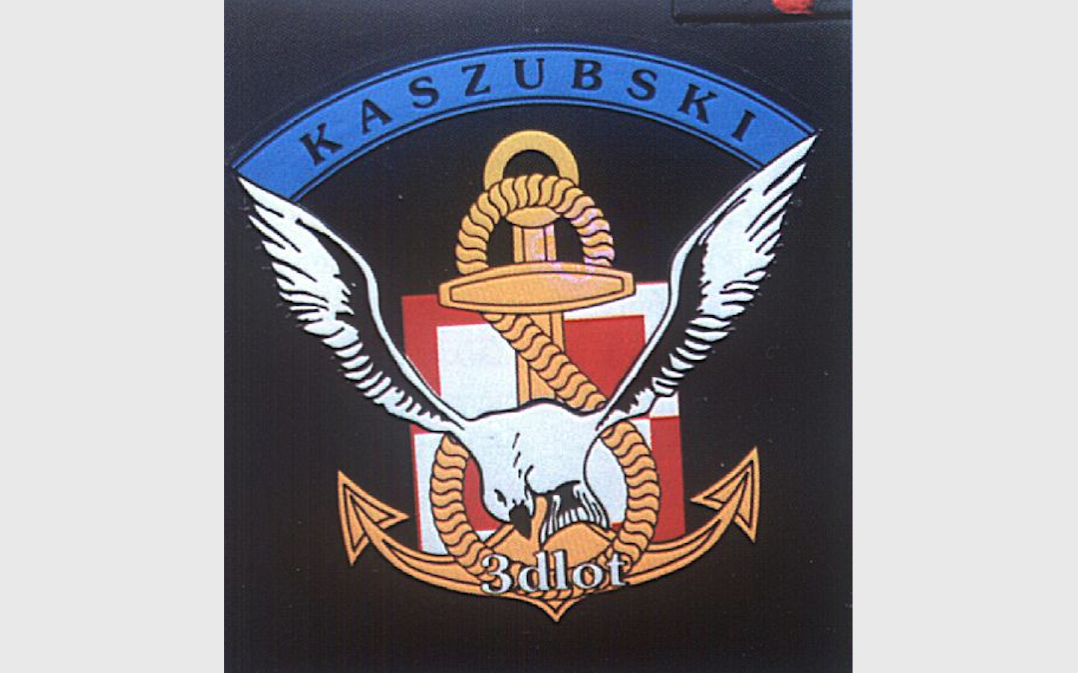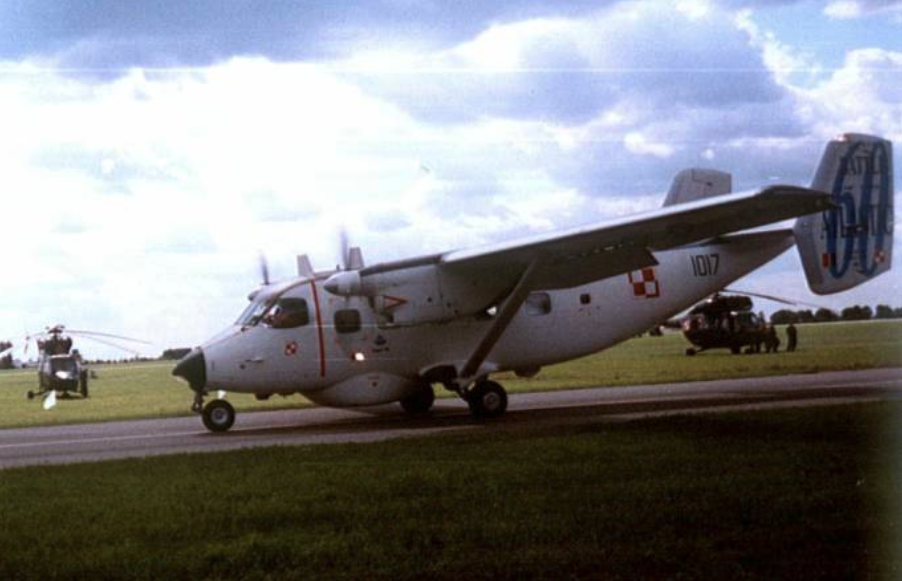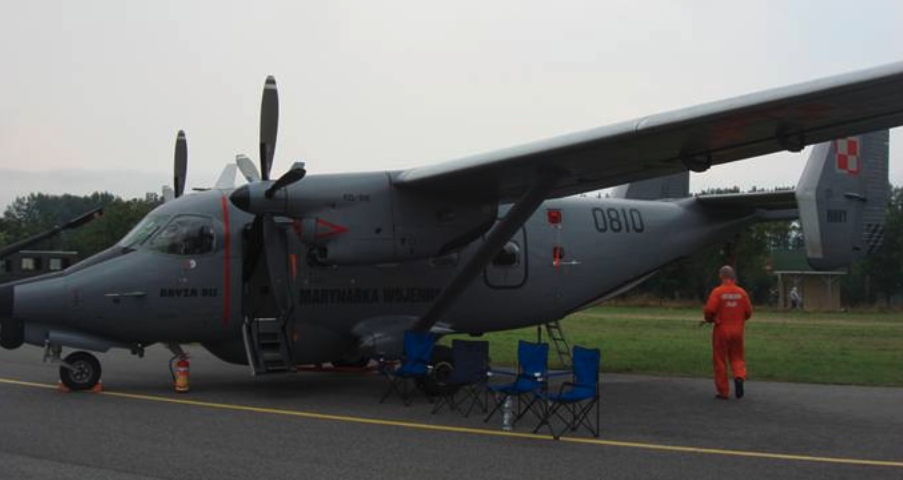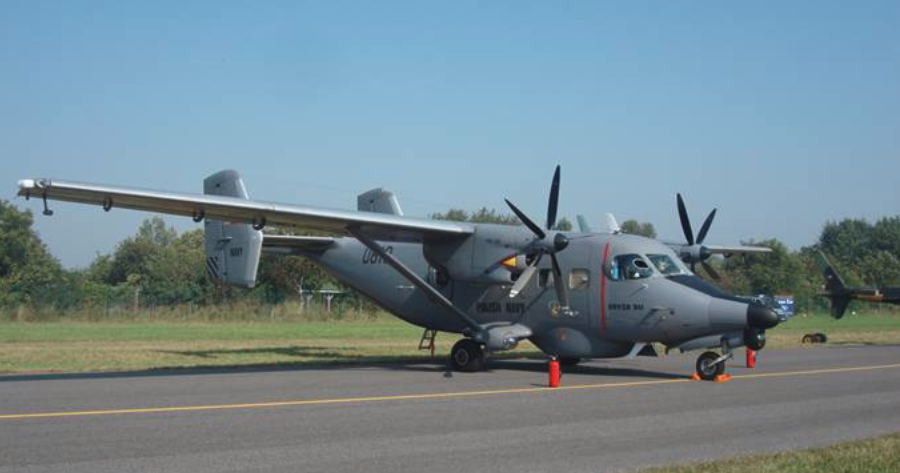Siemirowice 2014-03-25
30th Kashubian Navy Patrol and Reconnaissance Aviation Squadron.
Siemirowice Airport.
January 1, 2003. – December 31, 2010.

History.
See 7th Aviation Regiment of the Polish Navy, 30th Aviation Regiment of the Polish Navy. 1944-1995.
The result of another restructuring in the Polish Naval Aviation was the transformation of the squadron into the 30th Navy Patrol and Reconnaissance Aviation Squadron on January 1, 2003. In 2007, the unit additionally adopted a distinctive name and became the 30th Kashubian Aviation Squadron.
In 2004, during the celebration of the Unit Day, the Squadron officially took over the traditions of the 304th "Silesian Land" Squadron named after Prince Józef Poniatowski and became a continuator of the combat traditions of the Polish Naval Pilots from World War II. The squadron also officially obtained the right to use the badge of the 304th Squadron on its aircraft. The unit celebrated the holiday on August 28.
At the same time, by order of the Commander of the Navy of April 28, 2002, as of January 1, 2003, the 44th Naval Air Base was formed on the basis of the disbanded 4th and 5th Security Battalions. To commemorate the date of the Navy Commander's order to relocate the 50th Naval Airfield Maintenance Battalion to the Siemirowice Garrison, the unit's holiday was celebrated on May 13.
The transformation of the Squadron into a Squadron was mainly caused by a decrease in the quantity of equipment used. MiG-21 bis combat aircraft and PZL TS-11 Iskra training aircraft were withdrawn from service. The last flight on the TS-11 Iskra aircraft in the colors of MW Aviation took place on February 25, 2003. The tasks performed by the unit have changed and are: "Implementation of reconnaissance tasks, as well as monitoring the development of the operational and tactical situation on long-range approaches to the Naval Defense Zone and in its area of operational interest." In fact, the unit was reduced to a reconnaissance role, without the ability to perform combat tasks. It became a support for SAR operations.
Let us recall that there was a proposal to transform several PZL I-22 Iryda aircraft into combat aircraft for naval aviation. However, these plans were not implemented. Military education, but the Ministry of National Defense, did not want these planes either. At that time, the Minister of National Defense was Bronisław Komorowski, later the President of the Republic of Poland, with strong ties to the Moscow state and foreign agencies. Among other things, he did not remove from service high-ranking officers of the Polish Army who did not pass verification by the NATO alliance. Moreover, Bronisław Komorowski gave them access to the greatest defense secrets of the Republic of Poland and NATO.
The Naval Squadron continued to participate in numerous international exercises.
2003.
In 2003, the M-28 Bryza nb 1017 aircraft won the competition for the most beautiful livery at the Fairford air show in the UK.

2007.
In the first decade of the 21st century, the 30th Naval Aviation Squadron in Siemirowice performed a lot of flights. The racing season started very early. There were years when conditions were favorable for starting training as early as January 5. A new year always brought new hopes. The flying training season usually ended at the beginning of December. Less often in November. This was related to the implementation of the raid plan, or possibly to the lack of funds to complete the planned exercise program.
Since the Squadron had mainly PZL M-28 Bryza planes, which were younger machines at that time, there were no major problems with keeping the machines in full working order.
The gathering of the Squadron's pilots and the pre-flight briefing usually took place at the PPS, right next to the machines, and was led by the Squadron Commander. Tasks were distributed. Then there were pre-flight activities performed by the ground staff, and the crew commander discussed the details of individual elements of the flight with the crew. The squadron, whenever possible, practiced flights in a row. The M-28 Bryza plane is not an agile plane and, as a relatively slow machine, is susceptible to turbulence. Therefore, a flight of three or four machines in a staircase configuration is difficult. It's easier to fly in a row. A common flight route was a circular flight; Siemirowice – Czarna Dąbrówka – Bytów – Sierakowice – Linia – Lębork – Cewice. The crews reconnoitered ground and surface objects. Targeted life raft imitators were also dropped. There was a successful touchdown landing, which the crews described as a landing gear test. Two cameras were used to assess this element. One is placed right next to the touchdown site, perpendicular to RWY. The second point of touchdown along the RWY axis was the painted "dot". The main landing gear wheels should touch the ground there. The most correct landing profile was also taken into account. Landings were performed alternately by crew captains and co-pilots. An analysis of the machine recorders showed that there was never a so-called hard landing. An important element of the flight was making circles over the recognized object in such a way as not to lose sight of the object even for a moment.
An important element of the exercises was the composition of the crews for a given flight. Sometimes the crew composition for a given aircraft was determined by drawing lots. No one knew for sure what team he would fly with. This was a very good solution because it protected the pilots from routine and allowed for an objective assessment. It indicated elements for improvement. There was healthy competition in the Squadron. At that time, outstanding pilots included; pilot lieutenant Tomasz Zgoda and pilot lieutenant Robert Nowakowski. Often, after exercises, the pilots went to the Garrison Club, where the best performers in a given exercise, indicated by the commander, "funded the first round after hours".
The distinctive name "Kaszubska" was granted by decision No. 615/MON of December 27, 2007.
2008.
In the first decade of the 21st century, it became a tradition to combine the celebration of the 30th Kashubian Aviation Squadron with Open Days. On September 5, 2008, the Open Day was organized again. The day before (September 4, 2008), a ceremonial meeting was held, during which the commemorative order was read and distinctions, awards and promotions were presented. On September 5, 2008, a demonstration of the training of PZL M-28 Bryza aircraft crews was organized for guests. A competition was organized to test the accuracy of dropping a life raft imitator. The raft imitator was dropped into a fire-fighting pool with dimensions of 2 x 2 m. The optimal flight parameters for the drop are a speed of between 200 - 220 km/h at an altitude of 100 m. This operation takes place without instruments. To obtain the best possible effect, the crew had to take into account the direction and strength of the wind as well as the forward speed when the imitator was falling to the target. During an actual rescue operation, the raft weighing approximately 60 kg should be within 50 m of the survivor, on the side that ensures automatic drift towards the injured person. Before landing, the crews performed a mid-air assembly, and the competition ended with a flight in the "stairs" formation. The winning crew consisted of: commander, captain, pilot Robert Maciejuk, co-pilot, lieutenant Maciej Tomczyński, navigators, captain Zbigniew Gutowski, warrant officer Marek Żuk, warrant officer Wojciech Ledzion, and on-board technician, warrant officer Sławomir Turek; received a cup and congratulations from the commander of the Gdynia Naval Aviation Brigade, Commander Pilot Stanisław Ciołek. The distinction was awarded to the crew: commander, pilot lieutenant Tomasz Zgoda, co-pilot lieutenant Robert Nowakowski, navigator warrant officer Wiktor Kozioł, on-board technician petty officer Roman Czoch and cadets of the Dęblin "Szkoła Orląt" Kacper Majka and Marcin Ksyta. After the awards ceremony, there was a static display of aviation equipment, and there was also a traditional military pea soup.
2009.
On September 4, 2009, at the airport in Siemirowice, celebrations of the 30th Kashubian Air Squadron took place on August 28. The postponement of the celebration date was related to the participation of the crew of the M-28 Bryza Bis patrol and reconnaissance aircraft in the 2009 edition of the Air Show in Radom. In addition to the families of the pilots and invited guests, representatives of all units of the Gdynia Naval Aviation Brigade participated in the celebration of the unit's day. The holiday was an opportunity to summarize the unit's achievements.
The squadron actively participated in national and international exercises. Crews of patrol and reconnaissance aircraft equipped with radar for observing surface objects patrol the waters of the Baltic Sea, perform tasks of reconnaissance of ships and determining the nature of their activities. Crews on combat duty, thanks to the aircraft being equipped with a device for detecting signals from rescue radio stations and the ability to drop a rescue raft, support the national SAR system. They can take part in search operations. They also support the operations of ships during artillery and missile firing. The crews of PZL M-28/An-28 E aircraft, equipped with a scanner for detecting and measuring pollution on the water surface, in cooperation with Maritime Office inspectors, conduct ecological monitoring of the Polish Economic Zone in the Baltic Sea.
Formation flights and drop accuracy competitions are the main elements of the celebration of the 30th Kashubian Air Squadron. The skill of precise piloting necessary to properly perform the task of dropping the life raft has become the second showcase of the squadron from Siemirowice, next to patrol and reconnaissance tasks.
The holiday was full of many aviation attractions. Just before 12:00, PZL Mi-2 and SH-2G helicopters from Gdynia Babich Doły, as well as an anti-submarine helicopter Mi-14PŁ from Darłowo arrived at the airport. Additionally, three M-28/An-28 Bryza planes of various versions were placed on the airport tarmac.


2010.
On January 31, 2010, the 44th Naval Air Base was transformed into the 44th Naval Aviation Base. The unit's structure included the 30th Kashubian Air Squadron stationed at the airport in Siemirowice and the 29th Darłowo Air Squadron stationed at the airport in Darłowo.
Commanders of the 30th Naval Aviation Squadron:
Lieutenant Commander pilot Waldemar Kilarski (2003). Lieutenant Commander pilot Zbigniew Panek (2003-2004). Lieutenant Commander pilot Zbigniew Maksymiuk (2004-2006). Acting Commander, Second Lieutenant, pilot Bartosz Gadowski (2006-1/04/2007). Lieutenant Commander pilot Jarosław Andrychowski (1/04/2007 - 31/12/2010).
Commanders of the 44th Naval Air Base in Siemirowice:
Commander Reginald Jeliński (2003 – 2007). Commander Krzysztof Grudnowski (2007 – 2010).
Airplanes.
The squadron was equipped with M-28/An-28B1R patrol and reconnaissance aircraft, its modernized version adapted to search for submarines and conduct passive electronic reconnaissance M-28/An-28B1RM Bis, and M-28/An-28E ecological monitoring aircraft.
As of 2009:
M-28/An-28B1R patrol and reconnaissance aircraft with tactical numbers 1006, 1008, 1017, 1022, 1114, 1115, 1116.
M-28/An-28B1RM Bis patrol and reconnaissance aircraft with tactical number 0810.
M-28/An-28E ecological monitoring aircraft with tactical numbers 0404, 0405.
Written by Karol Placha Hetman
